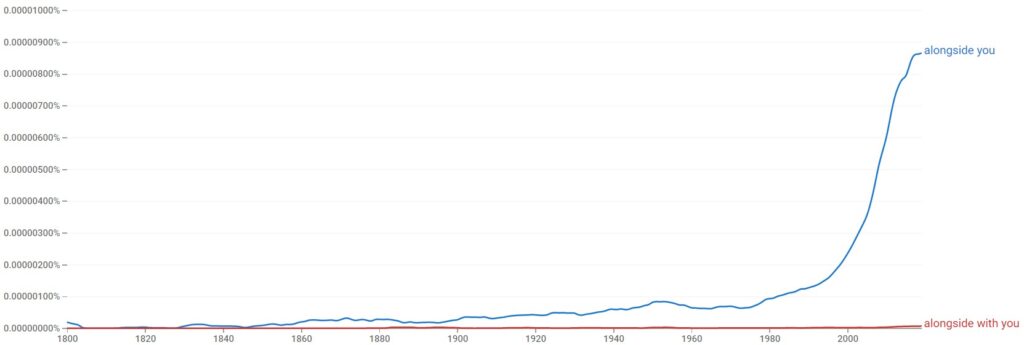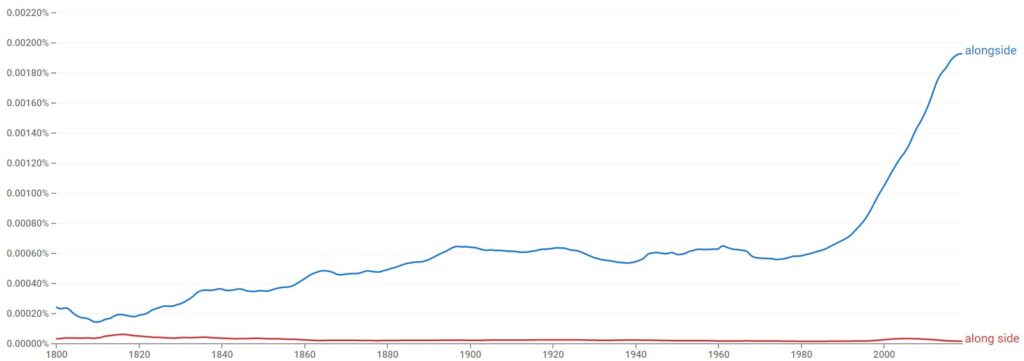This article discusses the meaning of the two phrases “work alongside you” and “work alongside with you.” We also provide guidance as to whether or not they are expressions that can be used appropriately in the English Language or if they are a poor grammatical construction.
Is It “Work Alongside You” Or “Work Alongside With You”?
The expression “work alongside with you” is not a common expression used in the English Language and should be avoided because it is redundant. “Work alongside you,” is more grammatically correct but still somewhat uncommon. The more correct and common phrase to use is “work with you.”

The phrase “work alongside with you” is considered redundant because of the definition of the word “alongside.” The Cambridge Dictionary defines “alongside” as “next to, or together with.”
Since the word “with” is included in the definition, saying it a second time makes it redundant. It would be like saying “work alongside together with with you,” which, of course, does not make sense.
Is It Ever Correct To Use “Work Alongside With You”?
It is never commonly accepted or correct to use “work alongside with you” in this exact syntax. Doing so makes a redundant phrase and is poor grammar. You will not hear the expression used like this in any style guide or other resource.
The Google Ngram Viewer here reaffirms that the phrase “work alongside with you” is never used. The line on the graph that represents “alongside with you” is entirely flat historically and to the present day.

You can use the word “with” and the phrase “work alongside” in the same sentence; however, the position of the word “with” must be in a different place. It also tends to sound a little clumsy or incorrect still even when moved.
Here are some examples that show how you could use the words in the same sentence.
- I mostly work alongside Maria and sometimes with Thomas as well.
- I want you to work alongside both myself and Michael with regard to the upcoming project.
- I work with Sarah and alongside you also.
- I work alongside the technology group and occasionally with the support team.
What Does It Mean To “Work Alongside” Someone?
When you “work alongside” someone it means that you are doing something closely with the other person. You and the other person (or people) are completing the same work and collaborating with each other in some way.
Remember that the definition of “alongside” includes the meaning “next to” as well as “together with.” Therefore, it is often implied that you are not only working on the same project as the other person, but you are also within close proximity to them physically as well.
Examples Of How To Use “Work Alongside You” In A Sentence
Here are some examples of how “work alongside you” can be used in a sentence.
- His assistant will be working alongside him for the duration of the event.
- It has been a great honor to work alongside you on this project.
- I’m excited to work alongside you at camp this summer. It will be fun!
- A good boss is one that will work alongside his or her employees and get to know them.
- I’d rather work alongside you when setting up the party, I don’t get along too well with Alex.
- Your employees should feel comfortable working alongside you on a day-to-day basis.
- Miles said that his preference was to work alongside you on Saturday.
Is It “Alongside” Or “Along Side”?
Spell “alongside” as a single word without any spaces. “Along side” is incorrect and does not have the same meaning. When spelled as two separate words with a space between them, you must interpret the meaning of both words separately. “Alongside” has its own distinct meaning.
The Google Ngram Viewer here shows that the two words “along” and “side” almost never appear side-by-side in this order. Contrarily, the word “alongside” without any spaces is used quite frequently.

Is It “Alongside You” Or “Alongside Of You”?
The proper phrase to use is “alongside you.” It is incorrect to use “alongside of you,” although you may still hear it said conversationally. Despite this fact, it is poor grammar and does not make logical sense in this syntax.
The reason that “alongside of you” does not make sense is due to the meaning of the word “of.” The words “of” either suggest the relationship between a part and a whole, or a scale and measure, or one thing that belongs to another thing.
The Cambridge Dictionary defines “of” as “used to show possession, belonging, or origin.” As you can see, the meaning of the phrase “alongside of you” would be technically interpreted as “alongside belonging to you” and would not make sense.
What Is The Difference Between “Work Alongside You” And “Work With You”?
The expressions “work alongside you” and “work with you” can be used interchangeably and imply the same meaning. Of the two phrases, “work with you” is the one that is more commonly used and accepted.
It is important to note that while the phrase “work alongside you” always suggests that the people are working closely together in the same physical location, the phrase “work with you” does not.
Although the phrase “work with you” can be used to mean in the same physical location, it also can just mean “working on the same thing” even if the people are not physically located together.
Here are some examples of when “work with you” does not indicate the people are physically together.
- I can work with you on it over the phone and see if that fixes the problem.
- I’m glad that I got to work with you on the project even though we’re miles apart.
- The hotel will assign someone to work with you as you plan your destination wedding.
Unless the context of the sentence specifies the location, as noted in the examples above, the phrase “work with you” can be interpreted either way by the audience.

Martin holds a Master’s degree in Finance and International Business. He has six years of experience in professional communication with clients, executives, and colleagues. Furthermore, he has teaching experience from Aarhus University. Martin has been featured as an expert in communication and teaching on Forbes and Shopify. Read more about Martin here.
